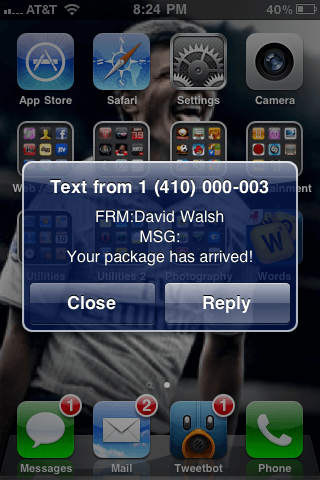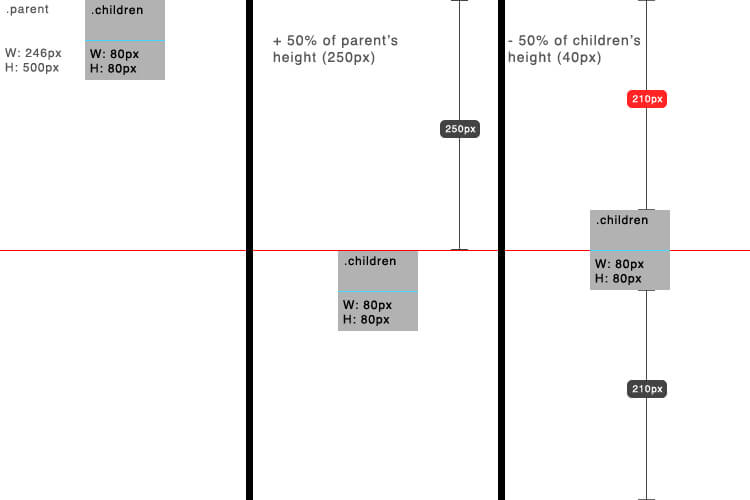Multi-Line JavaScript Strings
The JavaScript language performs automatic semicolon insertion at the end lines, so creating multiline strings usually ends up looking something like this:
var multiStr = "This is the first line" +
"This is the second line" +
"This is more...";
String upon string of concatenated JavaScript mess...ugly, slow, and ...ugly. Many novice JavaScript developers don't know that there's a better way to create multiline strings:
var multiStr = "This is the first line \
This is the second line \
This is more...";
Adding a backslash at the end of each line tells the JavaScript engine that the string will continue to the next line, thus avoiding the automatic semicolon insertion annoyance. Note that the second string includes line breaks within the string itself. Just another nice tip to add to your JavaScript arsenal!
![Send Text Messages with PHP]()
Kids these days, I tell ya. All they care about is the technology. The video games. The bottled water. Oh, and the texting, always the texting. Back in my day, all we had was...OK, I had all of these things too. But I still don't get...
![Creating Scrolling Parallax Effects with CSS]()
Introduction
For quite a long time now websites with the so called "parallax" effect have been really popular.
In case you have not heard of this effect, it basically includes different layers of images that are moving in different directions or with different speed. This leads to a...
![Assign Anchor IDs Using MooTools 1.2]()
One of my favorite uses of the MooTools JavaScript library is the SmoothScroll plugin. I use it on my website, my employer's website, and on many customer websites. The best part about the plugin is that it's so easy to implement.
I recently ran...
![CSS Vertical Centering]()
Front-end developing is beautiful, and it's getting prettier by the day. Nowadays we got so many concepts, methodologies, good practices and whatnot to make our work stand out from the rest. Javascript (along with its countless third party libraries) and CSS have grown so big, helping...





It should be noted the backslash multiline string notation is not part of any ECMAScript standards and can break various minifiers. Otherwise, it’s definitely good to know!
I think this is quite controversial. Other than issue with minifiers, ‘backslashes’ can cause error if there is any white space after it. I often write multiline string as arrays and join, this way IMO is quite readable.
var multiStr = [
"This is the first line",
"This is the second line",
"This is more..."
].join("\n");
You can also see the intent here wether it’s about construct a real multiline string (with join(“\n”)) or just try to avoid writing a long string (with join(“”)).
/*** @tungd : +1
*
* Moreover, you can't indent your code or it will add the whitespaces to the string.
*
* e.g:
**/
"my string \
is long" === "my string is long"; // and not "my string is long"
See also this performance test from different possibilities; the \ variant is the fastest.
I forgot about this implementation till this morning while I was working on some jQuery forms. Funny I came across this now.
While I understand the concern for minifiers, we don’t write JS for minifiers, we write JS for JS interpreters. JS minifiers need to improve. If the minifier you use doesn’t support this basic pattern, however, feel free to work around it.
When I first found out that you could escape newlines, I thought it was a pretty neat way to split a single line of text over several lines. It’s advantages are that it’s faster than concatenation and more readable than having the text spanning one long line that you have to scroll through.
However, it’s slower, less readable and less maintainable than having the text on one line and just turning on word wrap in your IDE. It’s also error prone, for reasons explained above.
The most common reason for including large, unbroken chunks of text in a JavaScript file is for the purposes of HTML injection, in which case I would personally include the text in a separate tag, which I then retrieve with innerText and store in a variable. That way, I can format it as HTML, but it won’t get shown on the page, nor get interpreted as JavaScript. Yes, it’s slower, but it’s much more readable and maintainable.
You can just use the first one, minifiers (at least uglify-js) will change the
var a = "foo" + "bar";intovar a = "foobar";anyway.In Google javascript guide, they advise “”+ instead of \ because . «The whitespace at the beginning of each line can’t be safely stripped at compile time; whitespace after the slash will result in tricky errors; and while most script engines support this, it is not part of ECMAScript.»
http://google-styleguide.googlecode.com/svn/trunk/javascriptguide.xml?showone=Multiline_string_literals#Multiline_string_literals
What do you think? Could you please enlighten me?
Thank you.
@David: i don’t think there’s much case for “improving” minifiers to support the escaped line feed. The structure itself is non-standard, some browsers don’t support it, so minifiers that adhere to the standards are right to reject that method. Besides, your own point defeats itself: it we write JS for JS interpreters, the implication is to write JS for the broadest compatibility possible. Escaped line feeds reduce that compatibility. And minifiers are increasingly essential tools to reduce bandwidth and execution time, so we SHOULD write JS with minifiers as part of the plan.
Personally, i find it no easier to read an escaped line feed than “a “+ “b “+ … There’s always something interrupting the end of the line. Sure, concatenating strings suffers a performance hit, but at the point it becomes significant, one should ask why such long strings are being statically coded into Javascript.
Am I missing something? It looks like string literal line continuations _are_ in the spec:
http://www.ecma-international.org/ecma-262/5.1/#sec-7.8.4
Maybe it’s relatively new but that’s from 2011…?
Ah, I read that more closely and now see that the backslash is only valid if it’s part of something else–not by itself like this post describes. My bad.
This is code will help to generate html code in javascript:….
Michael Haren: The backslash *isn’t* “by itself”; it’s the character right before a newline. However, the spec does specify (ha!) that the newline is *not* a valid character for escape purposes. The only valid escape characters after a backslash are listed explicitly: ‘ ” \ b f n r t v
Excellent, your blog’s always a lifesaver, thanks David!
But! There’s something new coming!
https://developer.mozilla.org/en-US/docs/Web/JavaScript/Reference/template_strings
Your two examples produce different results. I think many people will be surprised by the amount of whitespace in your multiline example.
But that’s not a multiline string! That is a multiline string literal representing a single-line string.
If you want to produce a multiline string (a variable in memory that, upon inspection during execution, contains more than one line of text), you don’t need the trailing backslash but the classic backslash + new line modifier.
The trailing backslash allows us to introduce line breaks in a string literal, mostly for clarity in the source code, without inserting them in the actual string represented by the literal.
https://jsfiddle.net/q68cktfq/
This is way outdated. Multiline string literal is accomplished with back tick.
@vance
`thing
thing2`
doesn’t work on iOS 6 tho
Note that the second string includes line breaks within the string itself.
If you meant that on the screen, then yes. But in the Javascript string itself, there are
_no_ line breaks (I mean newlines) inserted automatically (regardless if you run it in
old Rhino, Nashorn, or modern Node/V8) – at least I don’t see any ‘\n’ in your example.
Anyway, for cases where I couldn’t use post-ES6 JS features (template literals)
and I didn’t have to think about compatibility with anything outside, this
‘dirty’ hack has worked OK for me so far: https://stackoverflow.com/a/14496573